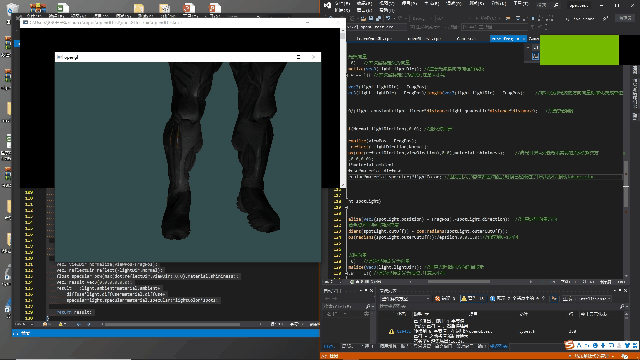环境配置以及视角修改和着色器亮度修改
首先注意我的文件生成目录为bin目录所以要用到的dll文件必须放到bin目录文件夹下面,而不是debug下面
- 调整视角位置更高一点
public:
Camera() {
fov = 45;
Position = glm::vec3(0.0f, 7.0f, 20.0f);
UP = glm::vec3(0.0f, 1.0f, 0.0f);
Front = glm::vec3(0.0f, 0.0f, -1.0f); //移动的距离在旋转和wasd移动时都要用到,注意这里用的是-1
}
- 调整的亮一点,取消光源衰减
result = (light.ambient*material.ambient
+diffuse*light.diffuse*material.diffuse
+specular*light.specular*material.specular)*lightColor;
而不是
result = (light.ambient*material.ambient
+diffuse*light.diffuse*material.diffuse
+specular*light.specular*material.specular)*lightColor*attenuation;
model函数
- 注意构造函数里边的参数应该是:Model(const char* path),因为你输入的是一个不变的量
- model函数实际上构建了一个又一个的mesh,所以在输出的时候是用的还是mesh.Draw
- 注意mesh向量数组的构建
- 本身就有处理obj的纹理的能力
#pragma once
#ifndef MODEL_H
#define MODEL_H
#include <glad/glad.h>
#include <glm/glm.hpp>
#include <glm/gtc/matrix_transform.hpp>
#include "stb_image.h"
#include <assimp/Importer.hpp>
#include <assimp/scene.h>
#include <assimp/postprocess.h>
#include "mesh.h"
#include "Shader.h"
#include <string>
#include <fstream>
#include <sstream>
#include <iostream>
#include <map>
#include <vector>
using namespace std;
class Model
{
public:
/* 函数 */
Model(const char* path)
{
loadModel(path); //调用模型路径加载函数
}
//渲染函数
void Draw(Shader shader)
{
for (unsigned int i = 0; i < meshes.size(); i++)
meshes[i].Draw(shader); //调用mesh的draw函数
}
private:
/* 模型数据 */
vector<Mesh> meshes;
string directory;
/* 加载模型函数 */
void loadModel(string path)
{
// 读取文件 via ASSIMP
Assimp::Importer importer;
const aiScene* scene = importer.ReadFile(path, aiProcess_Triangulate | aiProcess_FlipUVs); //用三角形|翻转Y轴|还有一个切线空间暂时用不到
// check for errors
if (!scene || scene->mFlags & AI_SCENE_FLAGS_INCOMPLETE || !scene->mRootNode) // if is Not Zero
{
cout << "ERROR::ASSIMP:: " << importer.GetErrorString() << endl;
return;
}
// retrieve the directory path of the filepath
directory = path.substr(0, path.find_last_of('/'));
// process ASSIMP's root node recursively
processNode(scene->mRootNode, scene); //通过路径寻找并且赋值
}
//递归去获取这些网格索引,获取每个网格,处理每个网格,接着对每个节点的子节点重复这一过程。
//结构都放进meshes里边
void processNode(aiNode* node, const aiScene* scene)
{
// 处理节点所有的网格(如果有的话)
for (unsigned int i = 0; i < node->mNumMeshes; i++)
{
aiMesh* mesh = scene->mMeshes[node->mMeshes[i]];
meshes.push_back(processMesh(mesh, scene)); //函数将一个新的元素加到vector的最后面,位置为当前最后一个元素的下一个元素
}
// 接下来对它的子节点重复这一过程
for (unsigned int i = 0; i < node->mNumChildren; i++)
{
processNode(node->mChildren[i], scene);
}
}
//将构造mesh函数放到model类里边
Mesh processMesh(aiMesh* mesh, const aiScene* scene)
{
vector<Vertex> vertices;
vector<unsigned int> indices;
vector<Texture> textures;
for (unsigned int i = 0; i < mesh->mNumVertices; i++)
{
Vertex vertex;
// 处理顶点位置、法线和纹理坐标
glm::vec3 vector; // we declare a placeholder vector since assimp uses its own vector class that doesn't directly convert to glm's vec3 class so we transfer the data to this placeholder glm::vec3 first.
// positions
vector.x = mesh->mVertices[i].x;
vector.y = mesh->mVertices[i].y;
vector.z = mesh->mVertices[i].z;
vertex.Position = vector;
// normals
vector.x = mesh->mNormals[i].x;
vector.y = mesh->mNormals[i].y;
vector.z = mesh->mNormals[i].z;
vertex.Normal = vector;
// texture coordinates
if (mesh->mTextureCoords[0]) // does the mesh contain texture coordinates?
{
glm::vec2 vec;
// a vertex can contain up to 8 different texture coordinates. We thus make the assumption that we won't
// use models where a vertex can have multiple texture coordinates so we always take the first set (0).
vec.x = mesh->mTextureCoords[0][i].x;
vec.y = mesh->mTextureCoords[0][i].y;
vertex.TexCoords = vec;
}
else
vertex.TexCoords = glm::vec2(0.0f, 0.0f); //没有纹理的情况
vertices.push_back(vertex);
}
// 处理索引
for (unsigned int i = 0; i < mesh->mNumFaces; i++)
{
aiFace face = mesh->mFaces[i];
// retrieve all indices of the face and store them in the indices vector
for (unsigned int j = 0; j < face.mNumIndices; j++)
indices.push_back(face.mIndices[j]);
}
//处理材质
//把所有的材质按照类型分类放到向量里边
if (mesh->mMaterialIndex >= 0)
{
//注意这里是给材质对象赋值
aiMaterial* material = scene->mMaterials[mesh->mMaterialIndex];
//分别构造两个纹理数组存放漫反射和镜面反射纹理
vector<Texture> diffuseMaps = loadMaterialTextures(material,
aiTextureType_DIFFUSE, "texture_diffuse");
textures.insert(textures.end(), diffuseMaps.begin(), diffuseMaps.end()); //填充
vector<Texture> specularMaps = loadMaterialTextures(material,
aiTextureType_SPECULAR, "texture_specular");
textures.insert(textures.end(), specularMaps.begin(), specularMaps.end());
}
return Mesh(vertices, indices, textures);
}
//加载与存储纹理
vector<Texture> loadMaterialTextures(aiMaterial* mat, aiTextureType type,
string typeName)
{
vector<Texture> textures;
for (unsigned int i = 0; i < mat->GetTextureCount(type); i++)
{
aiString str;
mat->GetTexture(type, i, &str);
Texture texture;
texture.id = TextureFromFile(str.C_Str(), directory);
texture.type = typeName;
texture.path = str.C_Str();
textures.push_back(texture);
}
return textures;
}
//读取纹理文件
unsigned int TextureFromFile(const char* path, const string& directory)
{
string filename = string(path);
filename = directory + '/' + filename;
unsigned int textureID;
glGenTextures(1, &textureID);
int width, height, nrComponents;
unsigned char* data = stbi_load(filename.c_str(), &width, &height, &nrComponents, 0);
if (data)
{
GLenum format;
if (nrComponents == 1)
format = GL_RED;
else if (nrComponents == 3)
format = GL_RGB;
else if (nrComponents == 4)
format = GL_RGBA;
glBindTexture(GL_TEXTURE_2D, textureID);
glTexImage2D(GL_TEXTURE_2D, 0, format, width, height, 0, format, GL_UNSIGNED_BYTE, data);
glGenerateMipmap(GL_TEXTURE_2D);
glTexParameteri(GL_TEXTURE_2D, GL_TEXTURE_WRAP_S, GL_REPEAT);
glTexParameteri(GL_TEXTURE_2D, GL_TEXTURE_WRAP_T, GL_REPEAT);
glTexParameteri(GL_TEXTURE_2D, GL_TEXTURE_MIN_FILTER, GL_LINEAR_MIPMAP_LINEAR);
glTexParameteri(GL_TEXTURE_2D, GL_TEXTURE_MAG_FILTER, GL_LINEAR);
stbi_image_free(data);
}
else
{
std::cout << "Texture failed to load at path: " << path << std::endl;
stbi_image_free(data);
}
return textureID; //返回textureID
}
};
#endif
主函数修改
- 添加了model的构造函数
- 旋转修改模型改为绕着一个Y轴旋转
- 我自己定义了光源,所以并没有删除mesh函数的构造
int main() {
//初始化
GLFWwindow* window = init(); //创建一个窗口指针,因为里边是一个空指针所有init函数必须改变类型
//着色
Shader lightShader("lamp.vert", "lamp.frag");
Shader cubeShader("cube.vert", "cube.frag"); //使用封装shader类
glm::mat4 trans = glm::mat4(1.0f); //单位矩阵
glm::mat4 model = glm::mat4(1.0f); //模型矩阵:用于物体坐标转化为世界坐标
glm::mat4 view = glm::mat4(1.0f);
glfwSetInputMode(window, GLFW_CURSOR, GLFW_CURSOR_DISABLED); //防止窗口对鼠标进行拦截
//渲染引擎
glEnable(GL_DEPTH_TEST); //打开深度缓存
//生成mesh:光照用
Mesh mesh = processCubeMesh();
//使用model类生成model对象
Model ourModel("D:/openGLResource/bin/nanosuit/nanosuit.obj");
while (!glfwWindowShouldClose(window)) { //当需要退出时候退出
//因为每一个循环的进入时间不一样,确保推进的距离一样,要用到时间差
currentFrame = glfwGetTime();
deltaTime = currentFrame - lastFrame;
lastFrame = currentFrame;
processInput(window); //每个周期都调用键位函数
//动态变化摄像机位置
float radius = 10.0f; //半径
float camX = sin(glfwGetTime()) * radius;
float camZ = cos(glfwGetTime()) * radius;
//设置颜色值和透明度,需要链接opengl32库才行
glClearColor(0.2f, 0.3f, 0.3f, 0.1f); //背景
glClear(GL_COLOR_BUFFER_BIT | GL_DEPTH_BUFFER_BIT); //清理颜色或者深度缓存
//绘制立方体
trans = glm::mat4(1.0f);
model = glm::translate(trans, cubePositions[0]); //只变换位置用来区分不同的立方体
model = glm::rotate(model, (float)glfwGetTime(), glm::vec3(0.0f, 3.0f, 0.0f)); //角度(逆向),绕
view = camera.GetViewMatrix();
glm::mat4 projection; //投影
projection = glm::perspective(glm::radians(camera.fov), 800.0f / 600.0f, 0.1f, 100.0f); //透视投影:FOV,屏幕长宽比,近,远。
cubeShader.useShader();
//传值给传送多个矩阵让其发生位置变化
glUniformMatrix4fv(glGetUniformLocation(cubeShader.ID, "projection"), 1, GL_FALSE, glm::value_ptr(projection));
glUniformMatrix4fv(glGetUniformLocation(cubeShader.ID, "view"), 1, GL_FALSE, glm::value_ptr(view));
glUniformMatrix4fv(glGetUniformLocation(cubeShader.ID, "model"), 1, GL_FALSE, glm::value_ptr(model));
glUniform4f(glGetUniformLocation(cubeShader.ID, "lightPos"), cubePositions[1].r, cubePositions[1].g, cubePositions[1].b, 1); //注意lightposion的三个值,现在是齐次坐标
glUniform3f(glGetUniformLocation(cubeShader.ID, "viewPos"), camera.Position.r, camera.Position.g, camera.Position.b); //观察的方向
glUniform3f(glGetUniformLocation(cubeShader.ID, "front"), camera.Front.r, camera.Front.g, camera.Front.b); //相机朝向的方向
glUniform3f(glGetUniformLocation(cubeShader.ID, "objectColor"), 1.0f, 0.5f, 0.31f);
glUniform3f(glGetUniformLocation(cubeShader.ID, "lightColor"), 1.0f, 1.0f, 1.0f);
//绘制mesh
//mesh.Draw(cubeShader);
ourModel.Draw(cubeShader);
//绑定第二个立方体
model = glm::translate(trans, cubePositions[2]);
glUniformMatrix4fv(glGetUniformLocation(cubeShader.ID, "model"), 1, GL_FALSE, glm::value_ptr(model));
//mesh.Draw(cubeShader);//画第二个立方体
//ourModel.Draw(cubeShader);
//绘制光源
trans = glm::mat4(1.0f);
model = glm::translate(trans, cubePositions[1]);
model = glm::scale(model, glm::vec3(0.2f, 0.2f, 0.2f));
trans = projection * view * model;
lightShader.useShader(); //注意这是新的useShader了
glUniform3f(glGetUniformLocation(lightShader.ID, "lightColor"), 1.0f, 1.0f, 1.0f);
glUniformMatrix4fv(glGetUniformLocation(lightShader.ID, "transform"), 1/*个矩阵*/, GL_FALSE,
glm::value_ptr(trans)); //设置偏移矩阵
mesh.Draw(lightShader);
//ourModel.Draw(lightShader);
glfwSwapBuffers(window);
glfwPollEvents(); //立即处理已经到位的事件,如果没有这个就会一直渲染而不触发事件
}
//退出
glfwTerminate();
return 0;
}
结果
- 只有纹理的漫反射而没有什么衰减等因素的影响

- 只取消光衰减之后的样子,注意漫反射以及镜面反射

























 1154
1154











 被折叠的 条评论
为什么被折叠?
被折叠的 条评论
为什么被折叠?








